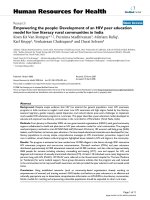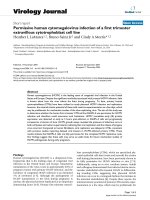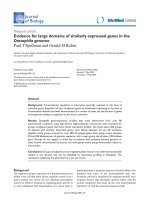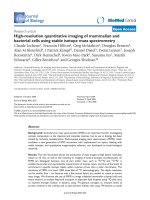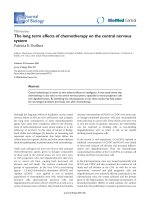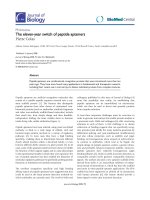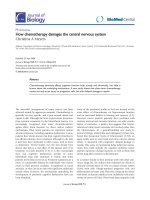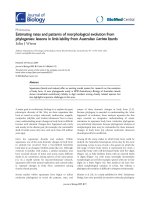Báo cáo sinh học: " Computing marginal posterior densities of genetic parameters of a multiple trait animal model using Laplace approximation or Gibbs sampling" doc
Bạn đang xem bản rút gọn của tài liệu. Xem và tải ngay bản đầy đủ của tài liệu tại đây (1.25 MB, 24 trang )
Original
article
Computing
marginal
posterior
densities
of
genetic
parameters
of
a
multiple
trait
animal
model
using
Laplace
approximation
or
Gibbs
sampling
A Hofer*
V
Ducrocq
Station
de
génétique
quantitative
et
appliquée,
Institut
national
de
la
recherche
agronomique,
78352
Jouy-en-Josas
cedex,
France
(Received
3
March
1997;
accepted
14
August
1997)
Summary -
Two
procedures
for
computing
the
marginal
posterior
density
of
heritabilities
or
genetic
correlations,
ie,
Laplace’s
method
to
approximate
integrals
and
Gibbs
sampling,
are
compared.
A
multiple
trait
animal
model
is
considered
with
one
random
effect,
no
missing
observations
and
identical
models
for
all
traits.
The
Laplace
approximation
consists
in
computing
the
marginal
posterior
density
for
different
values
of
the
parameter
of
interest.
This
approximation
requires
the
repeated
evaluation
of
traces
and
determinants,
which
are
easy
to
compute
once
the
eigenvalues
of
a
matrix
of
dimension
equal
to
the
number
of
animals
are
determined.
These
eigenvalues
can
be
efficiently
computed
by
the
Lanczos
algorithm.
The
Gibbs
sampler
generates
samples
from
the
joint
posterior
density.
These
samples
are
used
to
estimate
the
marginal
posterior
density,
which
is
exact
up
to
a
Monte-Carlo
error.
Both
procedures
were
applied
to
a
data
set
with
semen
production
traits
of
1957
Normande
bulls.
The
traits
analyzed
were
volume
of
the
ejaculate,
motility
score
and
spermatozoa
concentration.
The
Laplace
approximation
yielded
very
accurate
approximations
of
the
marginal
posterior
density
for
all
parameters
with
much
lower
computing
costs.
marginal
posterior
density
/
Laplace
approximation
/
Lanczos
method
/
Gibbs
sampling
/
genetic
parameters
Résumé -
Calcul
des
densités
marginales
a
posteriori
des
paramètres
génétiques
d’un
modèle
animal
multicaractère
en
utilisant
une
approximation
laplacienne
ou
l’échantillonnage
de
Gibbs.
Deux
procédures
de
calcul
de
la
densité
marginale
a
poste-
riori
des
héritabilités
et
des
corrélations
génétiques,
à
savoir
la
méthode
de
Laplace
pour
l’appro!imatiou
des
intégrales
et
l’échantillonnage
de
Gibbs,
sont
comparées.
Pour
cela,
nous
considérons
un
modèle
animal
multicaractère
avec
un
effet
aléatoire,
sans
observa-
tions
manquantes
et
avec
un
modèle
identique
pour
chaque
caractère.
L’approximation
de
*
Correspondence
and
reprints
**
On
leave
from
and
permanent
address:
Institute
of
Animal
Science,
Swiss
Federal
Institute
of
Technology
(ETH),
CLU,
CH-8092
Zurich,
Switzerland
Laplace
conduit
au
calcul
de
la
densité
marginale
a
posteriori
pour
différentes
valeurs
du
paramètre
qui
nous
intéresse.
Cela
nécessite
l’évaluation
répétée
de
traces
et
de
déterminants
qui
sont
simples
à
calculer
une
fois
que
les
valeurs
propres
d’une
matrice
de
dimension
égale
au
nombre
d’animaux
ont
été
déterminées.
Ces
valeurs
propres
peuvent
être
calculées
de
manière
e,f!cace
à
l’aide
de
l’algorithme
de
Lanczos.
L’échantillonnage
de
Gibbs
génère
des
échantillons
de
la
densité
conjointe
a
posteriori.
Ces
échantillons
sont
utilisés
pour
estimer
la
densité
marginale
a
posteriori,
qui
est
exacte
à
une
erreur
de
Monte
Carlo
près.
Les
deux
procédures
ont
été
appliquées
à
un
fichier
de
données
compor-
tant
les
caractères
de
production
de
semence
recueillies
sur
1957
taureaux
Normands.
Les
caractères
analysés
étaient
le
volume
de
l’éjaculat,
une
note
de
motilité
et la
concentration
en
spermatozoïdes.
L’approximation
laplacienne
a
permis
une
approximation
très
précise
de
la
densité
marginale
a
posteriori
de
tous
les
paramètres
avec
un
coût
de
calcul
beaucoup
plus
réduit.
densité
marginale
a
posteriori
/
approximation
de
Laplace
/
méthode
de
Lanczos
/
échantillonnage
de
Gibbs
/
paramètres
génétiques
INTRODUCTION
The
optimization
of
breeding
programs
relies
on
accurate
estimates
of
genetic
pa-
rameters,
ie,
heritabilities
and
genetic
correlations.
Genetic
evaluations
of
selection
candidates
by
best
linear
unbiased
prediction
(BLUP;
Henderson,
1973)
assumes
known
variance
components
which,
in
practice,
are
replaced
by
estimates.
Thus,
it
seems
desirable
to
have
an
idea
about
the
accuracy
of
the
estimates
used.
Restricted
maximum
likelihood
(REML;
Patterson
and
Thompson,
1971)
is
widely
regarded
as
the
method
of
choice
for
estimation
of
variance
components.
REML
estimates
have
known
large
sample
properties
under
the
concept
of
repeated
sampling
of
the
data
analyzed
but
unknown
small
sample
distributions.
In
contrast,
a
Bayesian
analysis
yields
an
exact
posterior
probability
density
of
the
parameters
of
interest
for
the
data
set
at
hand
(Gianola
and
Fernando,
1986).
REML
estimates
correspond
to
the
mode
of
the
posterior
distribution
marginalized
with
respect
to
the
location
param-
eters
in
a
Bayesian
analysis
with
flat
priors
for
fixed
effects
and
variance
components
(Harville,
1977).
Gianola
and
Foulley
(1990)
used
two
arguments
for
suggesting
an
alternative
method
for
variance
component
estimation.
First,
REML
estimates
are
joint
modes
of
all
(co)variance
components
rather
than
marginal
modes.
The
latter
are
a
better
approximation
to
the
posterior
mean,
which
is
the
optimum
Bayes
estimator
under
a
quadratic
loss
function.
Second,
if
interest
is
only
in
a
subset
of
the
(co)variance
components
the
remaining
(co)variance
components
should
be
regarded
as
nuisance
parameters
and
inferences
should
take
into
account
the
error
incurred
in
estimating
these
nuisance
variance
components.
Gianola
and
Foulley
(1990)
suggest
basing
inferences
about
the
variance
components
of
interest
on
their
marginal
posterior
density.
Various
methods
exist
for
marginalizing
the
joint
posterior
density
of
variance
components.
Analytical
integration
is
possible
only
for
certain
parameters
in
simple
univariate
models,
eg,
for
obtaining
the
marginal
posterior
density
of
the
variance
ratio
(or
the
heritability)
in
a
single
trait
linear
mixed
model
with
one
random
effect
(Gianola
et
al,
1990b).
With
more
complex
models,
approximations
or
Monte-Carlo
integration
techniques
are
used
to
obtain
marginal
posterior
densities.
Tierney
and
Kadane
(1986)
have
suggested
computing
marginal
posterior
densities
by
Laplace’s
method
to
approximate
integrals.
In
animal
breeding
the
method
was
first
considered
by
Cantet
et
al
(1992)
for
a
linear
mixed model
with
maternal
effects
and
has
been
applied
by
Tempelman
and
Gianola
(1993)
to
a
Poisson
mixed model
and
recently
by
Ducrocq
and
Casella
(1996)
to
a
mixed
survival
model.
Laplacian
integration
involves
the
repeated
computation
of
second
derivatives
of
the
logarithm
of
the
posterior
density
of
all
(co)variance
components
after
integration
of
location
parameters.
For
single
trait
animal
models
with
one
random
effect
or
for
multiple
trait
models
where
a
canonical
transformation
is
possible,
the
derivatives
can
be
efficiently
computed
once
all
eigenvalues
of
a
symmetric
matrix
of
dimension
of
the
number
of
animals
are
determined
(Robert
and
Ducrocq,
1996).
Robert
and
Ducrocq
(1996)
have
shown
that
the
Lanczos
algorithm
is
well
suited
to
computing
these
eigenvalues.
As
an
alternative,
Monte-Carlo
integration
can
be
used
to
obtain
the
exact
marginal
posterior
distribution
up
to
the
Monte-Carlo
error.
Gibbs
sampling
(Gelfand
and
Smith,
1990;
Casella
and
George,
1992),
a
Markov
chain
Monte-
Carlo
procedure,
is
becoming
an
increasingly
important
tool
in
statistical
analysis
(Gilks
et
al,
1996).
The
Gibbs
sampler
generates
samples
from
the
joint
(marginal)
posterior
distribution.
The
samples
are
used
to
derive
the
desired
summary
statistics
of
the
target
distribution.
Applications
in
animal
breeding
have
rapidly
increased
in
recent
years
(eg,
Wang
al,
1994;
Janss
et
al,
1995;
Sorensen
et
al,
1995;
Van
Tassell
and
Van
Vleck,
1996).
This
paper
considers
the
computation
of
the
marginal
posterior
density
of
heri-
tabilities
or
genetic
correlations
of
a
simple
multiple
trait
animal
model.
Heritabili-
ties
and
genetic
correlations
are
nonlinear
functions
of
(co)variance
components.
A
second
order
Laplace
approximation
of
marginal
densities
of
nonlinear
functions
has
been
derived
by
Tierney
et
al
(1989,
1991)
and
is
presented
in
detail.
The
Laplace
approximation
is
compared
to
Gibbs
sampling
by
applying
both
procedures
to
a
data
set
of
semen
production
traits
of
Normande
bulls.
METHODS
Model
Consider
the
multiple
trait
mixed
model
with
only
one
random
effect,
equal
incidence
matrices
for
all
t
traits
and
no
missing
observations:
where
y
is
the
vector
of
observations
of
order n !
t,
It
is
an
identity
matrix
of
order
t
by
t,
X
and
Z
are
known
incidence
matrices
of
order n
by
p
and
n
by
q,
respectively,
b
is
the
vector
of
fixed
effects
of
order
p .
t and
a
is
the
vector
of
random
additive
genetic
effects
of
order
(j
f
t,
and
e
is
the
vector
of
residuals
of
order n -
t.
The
conditional
probability
density
function
of
the
observations
is:
with
Ro
the
(co)variance
matrix
of
residual
effects
of
order
t by
t.
The
prior
distribution
for
the
unknown
location
parameters
are
assumed
to
be:
with
Go
the
matrix
of
additive
genetic
(co)variances
of
order
t by
t and
A
the
numerator
relationship
matrix
of
order
q
by
q.
For
the
(co)variance
matrices
the
prior
distribution
is
assumed
to
be
an
inverse
Wishart
distribution
(eg,
Gelman
et
al,
1995):
.
1
with
the
known
parameters
degree
of
belief
vi
(analogous
to
degrees
of
free-
dom)
and
scale
matrix
Vi
of
order
t by
t,
where
i
stands
either
for
G
or
R.
The
expected
value
of
the
inverse
Wishart
distribution
is
(for
example
for
Go)
E(G
owG
, V
G
) _
(v
G
- t - 1)-
1VG,
which
may
be
used
for
choosing
VG.
The
parameters
b,
a,
Go
and
Ro
are
assumed
to
be
independent
a
priori.
The
joint
posterior
probability
density
of
all
parameters
is
defined
as
the
product
of
the
probability
density
of
the
observations
and
the
joint
prior
density
of
the
parameters
and
can
be
written
as:
For
this
study
the
parameters
of
interest
are
functions
of
the
(co)variance
components
in
Go
and
R!,
ie,
variance
ratios
and
correlations.
Therefore,
0
is
a
nuisance
parameter
that
should
be
integrated
out
of
the
joint
posterior
density.
As
shown
by
Gianola
et
al
(1990a)
this
can
be
achieved
analytically
leading
to
the
following
marginal
posterior
probability
density
of
all
(co)variance
components:
where 9
[(Ro
<8
W’W)
+
(Go
1
®
£)) !
1 (Ra
1
®
W’)y
is
the
solution
to
the
mixed model
equations
(Henderson,
1973).
To
draw
inference
about
functions
of
a
subset
of
the
(co)variance
components,
a
further
marginalization
of
the
posterior
density
is
required.
Analytical
solutions
are
not
available.
Laplace
approximation
Approximation
of
marginal
posterior
probability
densities
using
Laplace’s
method
has
been
suggested
by
Tierney
and
Kadane
(1986).
They
considered
the
case
where
the
vector
of
parameters
can
be
partitioned
as
6
=
[o’i,
(
T2]
,
where
!1
is
the
parameter
of
interest
and
Q2
is
the
nuisance
parameter
that
is
integrated
out
of
the
posterior
distribution
using
Laplace’s
method
to
approximate
integrals.
Genetic
parameters
such
as
heritabilities
or
genetic
correlations
are
nonlinear
functions
of
(co)variance
components.
Inferences
about
genetic
parameters
should
therefore
be
based
on
marginal
densities
of
nonlinear
functions
of
(co)variance
components.
Tierney
et
al
(1989,
1991)
extended
the
work
of
Tierney
and
Kadane
(1986)
for
the
approximation
of
marginal
posterior
distributions
of
nonlinear
functions.
Let
T
=
g(u)
be
the
nonlinear
function
of
interest
of
the
m
parameters
in
0
&dquo;.
We
assume
here
that
T
is
a
scalar
(eg,
heritability
or
genetic
correlation)
but
this
assumption
is
not
required
for
the
following
derivation.
A
new
parameterization
is
defined
as
<1>(
0
&dquo;) =
{<I>l (0&dquo;),
<1>2 (
O
&dquo;n =
{g(
0
&dquo;),
!2(!)}
partitioned
into
the nonlinear
function
of
interest
and
a
function
4)2
that
ensures
that
the
transformation
is
one
to
one,
although
it
might
be
difficult
to
specify
<1>
2
explicitly.
The
approximation
proposed
by
Tierney
et
al
(1989,
1991)
does
not
depend
on
an
explicit
reparameterization.
The
only
requirement
is
the
existence
of
a
one
to
one
transformation
in
a
sufficiently
small
neighbourhood
U
of
the
joint
mode
6.
In
our
application
4)2
is
easy
to
specify
and
the
approximation
caused
by
the
restriction
to
the
neighbourhood
U
does
not
occur.
In
order
to
obtain
the
marginal
distribution
of’[ = g( 0&dquo;),
the
nuisance
parameters
u2
=
4Y2 (u) in
the
new
parameterization
must
be
integrated
out
where
J (4)
-1
!(r,U2))
is
the
Jacobian
matrix
of
the
transformation
<t> -1.
Let
8r
be
the
argument
on
the
original
scale
that
maximizes
log
p(6!y)
sub-
ject
to
the
constraint
g(u)
=
T.
In
the
new
parameterization
q!(8T)
maximizes
log
p( <t> -1 (g( 0&dquo;),
U2
)
Iy)
subject
to
the
constraint
g( 0&dquo;)
=
T.
At
the
constrained
mode
4
)(&,
r
),
the
gradient
of
the
Lagrangian
log
p(<t>
-l
(g(
O
&dquo;), U
2
)!y)
+ A(g(u) - -r)
is
zero,
where
A
is
a
Lagrange
multiplier.
Now,
log
p(
4
) -’(r,
u2
)ly)
in
[4]
for
fixed
T
is
approximated
using
a
second
order
Taylor
series
expansion
around
4)
2
(&
’
):
In
expression
[5]
the
part
that
depends
on
U2
is
the
kernel
of
a
normal
distribution
with
mean
<l>
2
(Ô’’1’)
and
variance
Qr,
22
.
The
normalizing
constant
of
this
kernel
is
(27r
) -
9
1 f2r,221 2,
which
leads
to
the
following
approximation
of
equation
[4]:
In
expression
[6]
S2
T,
22
and
J(6’-r)
depend
on an
explicit
specification
of
!2(!).
Following
Tierney
et
al
(1989, 1991),
we
now
derive
an
alternative
expression
for
[6]
that
does
not
require
an
explicit
reparameterization.
Let
S2T
and
HT
be
the
matrices
of
second
derivatives
of
the
Lagrangian
evaluated
at
the
constrained
mode
in
the
new
and
the
original
parameterization,
respectively,
ie
with
u’ =
[g( 0&dquo;),
u’],
and
Note
that
n!,!2
in
equation
[5]
is
equal
to
the
diagonal
block
of
fl-1
pertaining
to
u2
=
!2(!)!
Following
Meyer
and
Smith
(1996,
equation
53)
and
using
the
fact
that
the
gradient
of
log
p(!-1(g(a’),
u2
)ly)
+
A (g (u) - r)
is
zero
at
q!(8r) ,
we
have
evaluated
at u
=
8r.
This
leads
to:
Using
the
formula
for
the
determinant
of
the
partitioned
matrix
in
equation
[7]
(Searle,
1982)
and
recalling
that
n!,!2
is
equal
to
the
diagonal
block
of
S2T
I
pertaining
to
u2
=
<
P2
( u),
the
determinant
of
nor
can
be
obtained
as:
Substituting
InTI
=
IH
TIIJ 1
2
which
follows
from
equation
[7]
into
equation
[8]
yields:
This
equality
can
be
used
in
equation
[6]
to
obtain
the
following
approximation
of
the
marginal
probability
density
of
the
nonlinear
function
T
=
g(
6)
(Tierney
et al,
1989, 1991):
Note
that
in
contrast
to
equation
[6]
an
explicit
parameterization
<1>
2
is
not
needed
for
approximation
!9!.
To
obtain
the
marginal
posterior
probability
density
of
the
genetic
parameter
T
=
g(u),
equation
[9]
is
repeatedly
used
for
different
values
of
T.
In
equation
[9]
observed
second
derivatives
of
log
p(!!y)
are
required.
Model
[1]
allows
a
transformation
to
canonical
scale,
which
facilitates
the
computation
of
derivatives.
Colleau
et
al
(1989)
have
given
expressions
on
the
canonical
scale
for
the
derivatives
of
the
residual
likelihood,
which
is
one
part
of log
p(
C
Tly).
Derivatives
of
log
p(!!y)
on
the
canonical
scale
and
the
transformation
to
the
original
scale
are
given
in
the
Appendix.
Approximating
determinant
and
traces
Evaluation
of
the
marginal
density
!3!,
which
is
needed
in
equation
!9),
requires
the
computation
of
the
determinant
of
the
coefficient
matrix
of
the
mixed model
equations
for
each
canonical
trait
(Appendi!).
For
the
evaluation
of
derivatives
of
log
p(
C
Tly)
traces
involving
the
inverse
of
the
coefficient
matrix
of
the
mixed model
equations
on
the
canonical
scale
have
to
be
computed
(Appendi!).
The
computation
of
these
quantities
becomes
trivial
once
the
eigenvalues,
-y
2,
of L’Z’MZL
have
been
determined,
where
L
is
the
Cholesky
factor
of
A,
ie,
A
=
LL’,
and
M
is
the
absorption
matrix,
ie,
M
=
I -
X(X’X)-
1
X’.
For
the
determinant
we
have
(eg,
Gianola
et
al,
1990a):
The
traces
can
be
obtained
as
(eg,
Robert
and
Ducrocq,
1996):
The
procedure
described
by
Robert
and
Ducrocq
(1996)
can
be
used
to
compute
all
eigenvalues
of
L’Z’MZL.
Here
we
only
give
a
brief
outline,
for
details
see
Robert
and
Ducrocq
(1996)
and
the
references
cited
therein.
The
procedure
uses
the
Lanczos
algorithm
to
transform
the
original
matrix
B
=
L’Z’MZL
of
size
q to
a
tridiagonal
matrix
Tk
of
a
given
size
k,
which
in
theory
has
the
same
eigenvalues
as
B.
A
standard
method
can
then
be
used
to
compute
the
eigenvalues
of
Tk.
The
advantage
of
this
algorithm
is
that
memory
requirements
are
minimal
because
matrix
B
is
not
altered.
The
matrix-vector
product
Bv
needs
to
be
computed
repeatedly,
which
can
be
achieved
very
efficiently
taking
advantage
of
the
special
structure
of B
(Robert
and
Ducrocq,
1996).
Owing
to
rounding
errors
in
the
practical
application,
the
resulting
Lanczos
matrix
Tk
is
inaccurate.
When
the
size
k
of
Tk
is
increased,
the
eigenvalues
of
Tk
provide
increasingly
accurate
estimates
of
eigenvalues
of B.
For
k
>
q
Tk
has
’good’
eigenvalues
which
are
true
approximations
of
the
distinct
eigenvalues
of
B
but
also
extra
eigenvalues
which
are
either
copies
of
a
good
eigenvalue
or
spurious.
A
test
is
used
to
identify
the
spurious
eigenvalues.
A
numerically
multiple
eigenvalue
of
Tk
is
accepted
as
an
accurate
approximation
of
an
eigenvalue
of
B.
For
the
remaining
good
eigenvalues
an
error
estimate
is
computed
(Cullum
and
Willoughby,
1985).
The
Lanczos
algorithm
is
unable
to
determine
the
multiple
eigenvalues
and
their
multiplicities.
The
approach
used
by
Robert
and
Ducrocq
(1996)
for
identifying
the
multiple
eigenvalues
is
based
on
the
fact
that
if 7
is
a
multiple
eigenvalue
of
B,
then
it
will
also
be
an
eigenvalue
of
the
matrix
B
obtained
from
B
by
adding
a
symmetric
rank
one
matrix,
which
is
proportional
to
the
product
of
the
starting
vector
of
the
Lanczos
algorithm
and
its
transpose.
Hence
the
Lanczos
algorithm
is
applied
to
B
and
the
eigenvalues
of
the
resulting
Lanczos
matrix
Tk
that
are
also
eigenvalues
of
Tk
are
identified
as
multiple
eigenvalues
of
B.
Using
the
fact
that
the
multiplicity
ml
of
the
zero
eigenvalue
is
known
to
be q -
(n -
rank(X)),
the
multiplicity
mi
of
the
ith
multiple
eigenvalue -y
i
can
be
obtained
as
a
solution
to
the
set
of
the
following
three
equations:
subject
to
the
constraint
mi
>
1,
where
rm
is
the
number
of
multiple
and r
s
is
the
number
of
single
eigenvalues
of
B.
Robert
and
Ducrocq
(1996)
successfully
applied
this
method
to
a
model
with
one
fixed
effect.
Although
the
multiplicities
determined
were
not
consistent
for
different
sizes
of
the
Lanczos
matrix,
the
traces
were
very
well
approximated
using
these
multiplicities
even
for
a
Lanczos
matrix
of
size
k
=
2q.
Gibbs
sampling
The
Gibbs
sampler
(Gelfand
and
Smith,
1990;
Casella
and
George,
1992)
generates
samples
from
the
joint
posterior
distribution
by
repeatedly
sampling
from
the
fully
conditional
distributions
of
the
parameters.
Fully
conditional
densities
are
derived
from
the
joint
posterior
probability
density
given
in
equation
[2]
by
collecting
the
terms
that
involve
0.
These
terms
are
proportional
to
the
kernel
of
a
multivariate
normal
density
(eg,
Gianola
et
al,
1990a):
the
solution
to
the
mixed model
equations.
Therefore,
obtaining
a
new
realization
of
all
location
parameters
jointly
would
require
sampling
from:
which
is
impractical
for
larger
problems.
A
computationally
much
less
demanding
alternative
is
to
sample
one
location
parameter
at
a
time.
Let
e-
z
be
e
without
its
ith
component
and
c’
be
the
ith
row
of
C
without
its
ith
element.
Then,
a
new
realization
of
the
ith
location
parameter
9,
is
obtained
by
sampling
from
(eg,
Wang
et
al,
1994):
The
disadvantage
of
using
equation
[14]
is
that
the
samples
of
subsequent
cycles
show
higher
correlations
than
if
equation
[13]
were
used.
This
leads
to
a
slower
mixing
of
the
chain
and
therefore
a
lower
effective
number
of
independent
samples
(Sorensen
et
al,
1995),
ie,
a
lower
information
content
of
a
chain
of
given
length
(see
below).
Recently,
Garcfa-Cort6s
and
Sorensen
(1996)
have
shown
a
way
to
sample
from
equation
[13]
that
circumvents
the
need
for
the
inverse
of
the
coefficient
matrix
of
the
mixed
model
equations
but
requires
a
solution
to
the
mixed model
equations.
With
their
simulated
data
for
a
single
trait
animal
model,
the
effective
number
of
independent
samples
for
the
additive
genetic
variance
was
only
doubled
using
equation
[13]
instead
of
equation
(14!.
Because
computing
costs
for
equation
[13]
using
the
strategy
proposed
by
Garcia-Cortes
and
Sorensen
(1996)
are
increased
by
a
factor
much
larger
than
two
it is
concluded
that
equation
[14]
is
the
preferred
way
to
sample
the
location
parameters
in
single
trait
animal
models.
With
the
model
considered
here
the
canonical
transformation
can
be
used
to transform
the
correlated
traits
to
uncorrelated
variables.
This
allows
us
to
sample
the
location
parameters
on
the
canonical
scale
using
equation
(14),
which
is
equivalent
to
jointly
sampling
the
location
parameters
for
all
traits
of
one
effect
on
the
original
scale.
To
improve
mixing
of
the
chain
additive
genetic
values
for
sires
and
their
final
progeny
can
be
sampled
jointly
as
proposed
by
Janss
et
al
(1995).
The
fully
conditional
distribution
for
the
genetic
(co)variance
matrix
Go
is:
using
the
fact
that
e/(G010!)e=tr(SaGOl),
where
Sa={a!A-1aj}
for
i
=
1, ,
t and j
=
1, ,
t,
and
ai
is
the
vector
of
additive
genetic
effects
for
trait
i.
The
conditional
distribution
is
in
the
form
of
an
inverse
Wishart
distribution
with
q +
vG
degrees
of
freedom
and
scale
matrix
VG
+
Sa.
Similarly,
the
fully
conditional
distribution
for
the
residual
(co)variance
matrix
Ro
is:
where
e
=
y -
(I
d
9W)8, S
e
=
{eie! !
for
i
=
1, ,
t and j
=
l, ,
t, and
ei
is
the
subvector
of e
for
trait
i.
This
is
an
inverse
Wishart
distribution
with
n+v
R
degrees
of
freedom
and
scale
matrix
VR
+
Se.
Sorensen
(1996),
among
others,
describes
an
algorithm
for
sampling
from
the
inverse
Wishart
distribution.
One
cycle
of
Gibbs
sampling
consists
in
drawing
samples
in
turn
from
equa-
tion
[14]
for
all
location
parameters
followed
by
equations
[15]
and
!16!.
After
con-
vergence
to
the
target
distribution,
the
samples
obtained
are
from
the
joint
poste-
rior
distribution,
or
if
only
one
parameter
is
considered,
then
samples
are
from
the
appropriate
marginal
distribution.
Samples
from
the
marginal
posterior
density
of
the
nonlinear
function
g(u)
can
be
easily
obtained
by
applying
g( 0’)
to
the
samples
generated
for
6
in
each
cycle
of
the
Gibbs
sampler
(eg,
Wang
et
al,
1994).
APPLICATION
Data
The
methodology
was
applied
to
data
set
DS2
of
Ducrocq
and
Humblot
(1995)
with
semen
production
traits
of
1957
Normande
bulls
born
between
1976
and
1986.
The
three
traits
considered
were
volume
of
the
ejaculate
(mL),
motility
score
(on
a
scale
from
0
to
4)
and
spermatozoa
concentration(10
9
/mL).
The
observations
available
were
means
of
these
traits
for
11.4 !
3.6
sperm
collections.
There
were
no
missing
observations.
The
means +
standard
deviations
were
3.08 !
0.88,
2.99 !
0.63
and
0.98 !
0.26
for
volume,
motility
and
concentration,
respectively.
All
known
ancestors
without
records
were
added
with
the
exception
of
ancestors
that
provided
no
additional
information,
ie,
ancestors
with
both
parents
unknown
and
only
one
progeny.
The
total
number
of
animals
considered
was
5
566.
Further
details
about
this
data
set
are
given
by
Ducrocq
and
Humblot
(1995).
Model
The
same
model
as
considered
by
Ducrocq
and
Humblot
(1995)
was
used
for
each
of
the
three
traits.
The
two
fixed
effects
were
birth
year
x
birth
trimester
x
station
of
performance
test
(65
classes)
and
the
effect
of
total
number
of
sperm
collections
(six
classes:
unknown,
<
6,
7-9,
10-12,
13-15,
>
15).
The
additive
genetic
effect
was
the
only
random
effect.
Because
the
number
of
sperm
collections
that
made
up
a
record
did
not
vary
much,
and
for
simplicity,
a
constant
residual
variance
was
assumed
for
each
of
the
three
traits.
Proper
inverse
Wishart
distributions
were
assumed
as
priors
for
the
matrices
of
genetic
and
residual
(co)variances.
The
degree
of
belief
parameters
were
arbitrarily
set
to
20
for
both
prior
distributions.
The
scale
matrices
were
chosen such
that
the
expected
values
correspond
to
the
phenotypic
standard
deviations
found
in
the
raw
data
(see
above)
with
heritabilities
of
0.5
for
all
three
traits
and
genetic
and
residual
correlations
of
-0.2
between
volume
and
motility
as
well
as
concentration
and
of
0.6
between
motility
and
concentration.
The
expected
prior
heritability
of
0.5
for
means
of
about
ten
observations
correspond
to
a
heritability
of
around
0.1
I
for
single
observations.
The
chosen
prior
distribution
reflects
our
prior
belief
based
on
literature
values
(Ouali,
1984;
Taylor
et
al,
1985;
Makulska
et
al,
1993).
Implementation
of
Laplace
approximation
Eigenvalues
of
L’Z’MZL
were
computed
using
Lanczos
matrices
of
size
2q,
4q,
8q
and
12q.
Multiple
eigenvalues
and
their
multiplicities
were
determined
using
the
procedure
of
Robert
and
Ducrocq
(1996)
described
above.
As
observed
already
by
Robert
and
Ducrocq
(1996),
eigenvalues
were
difficult
to
estimate
in
some
intervals.
With
increasing
size
of
the
Lanczos
matrix,
new
eigenvalues
were
detected
in
these
intervals
and
the
intervals
with
eigenvalues
of
low
precision
became
smaller.
These
observations
led
to
a
new
strategy
where
intervals
with
eigenvalues
with
high
error
estimates
had
the
first
eigenvalue
with
an
error
estimate >
10-
5
on
each
side
of
the
interval
arbitrarily
declared
as
a
multiple
eigenvalue
in
order
to
compensate
for
the
eigenvalues
not
yet
detected
in
the
interval.
For
these
’multiple’
eigenvalues
and
the
multiple
eigenvalue
of
0.5
found
with
the
procedure
of
Robert
and
Ducrocq
(1996)
multiplicities
were
estimated
with
equations
!10!,
(11!
and
!12!,
using
a
least
squares
procedure.
Integer
programming
was
also
attempted
but
failed
on
all
occasions.
Application
of
the
formula
for
the
Laplace
approximation
[9]
requires
maximiza-
tion
of
log
p( O&dquo;ly)
subject
to
the
constraint
g( 0&dquo;) -
T
=
0.
The
iterative
algorithm
used
to
solve
this
problem
follows
ideas
developed
by
Bard
(1974,
ch
6-6).
First,
log
p(!!y)
is
approximated
by
a
second
order
Taylor
series
expansion
around
the
current
estimate
8!
at
round
r:
where
b6
=
u -
6’ .
Similarly,
g(o-) -
T
is
approximated
by
a
first
order
Taylor
series
expansion:
Now,
p
is
maximized
subject
to
the
constraint !
=
0,
which
is
equivalent
to
finding
the
stationary
point
of
the
Lagrangian
p +
A!.
Setting
the
first
derivatives
of
the
Lagrangian
with
respect
to
b6
and
A
to
zero
leads
to
the
following
system
of
equations:
The
derivatives
are
evaluated
at
the
current
value
of
8!.
The
new
solution
is
then
found
as
CT
=
CT
+
58!!!.
In
our
implementation
observed
second
derivatives
in
equations
[17]
were
replaced
by
expected
second
derivatives,
which
are
faster
to
compute
as
will
be
shown
below.
Expected
values
for
second
derivatives
on
the
canonical
scale
for
the
residual
likelihood,
which
is
one
part
of
log
p(uly),
were
derived
by
the
method
of
Meyer
(1985).
First
derivatives
and
expected
values
of
second
derivatives
of log
p(Q!y)
on
the canonical
scale
and
the
transformation
to
the
original
scale
are
given
in
the
Appendix.
Once
the
constraint
was
met
log
p(!!y)
was
computed
for
the
proposed
new
solution
and
if
necessary,
step
size
was
successively
halved
until
the
density
was
found
to
increase.
Iterations
were
stopped
when
the
maximum
absolute
change
of
heritability
or
genetic
correlation
estimates
was
less
than
0.001.
At
convergence,
observed
second
derivatives
were
computed
for
use
in
equation
(9!.
The
computation
of
derivatives
of
log
p(oyy)
involves
the
solution
to
the
mixed
model
equations
on
the canonical
scale.
Single
trait
mixed model
equations
were
iteratively
solved
for
each
canonical
trait
by
successive
overrelaxation
using
a
relaxation
factor
of
1.8
and
solutions
obtained
in
the
previous
round
of
the
constrained
maximization
by
equation
[17]
as
starting
values.
The
sum
of
squared
differences
between
solutions
in
successive
rounds
of
iterations
divided
by
the
sum
of
squared
solutions
in
the
current
round
was
used
as
stopping
criterion
and
was
set
to
10
-12
.
The
computation
of
observed
second
derivatives
involves
the
quadratic
form
aiA-1C!°A-lai,
where
ai
is
the
solution
to
the
mixed
model
equations
for
additive
genetic
effects
for
canonical
trait
i and
Cq
a
is
the
submatrix
of
(W’W
+
a!E)-1
(the
inverse
of
the
coefficient
matrix
of
the
mixed model
equations
for
canonical
trait
j)
pertaining
to
additive
genetic
effects.
This
quadratic
form
was
evaluated
by
first
computing
Ûi
=
A-’iii,
followed
by
iteratively
solving
the
mixed model
equations:
In
addition
to
the
Laplace
approximation
[9]
a
computationally
less
demanding
approximation
of
the
marginal
posterior
distribution
was
obtained
by
replacing
the
matrix
of
observed
second
derivatives
in
equation
[9]
by
the
matrix
of
expected
second
derivatives.
This
approximation
will
be
called
LaplaceE
in
the
following.
For
heritabilities
(genetic
correlations)
both
approximations
were
computed
for
35
(55)
values
equally
spaced
by
0.02
that
covered
the
expected
range
of
non-
negligible
densities.
For
a
more
accurate
location
of
the
mode
an
additional
three
values
spaced
by
0.005
were
evaluated
in
the
intervals
on
each
side
of
the
value
with
the
highest
posterior
probability
density.
The
normalizing
constant,
the
mean
and
quantiles
of
the
marginal
posterior
densities
were
computed
by
simple
numerical
integration
using
the
trapezoidal
rule.
Implementation
of
Gibbs
sampling
The
Gibbs
sampler
was
run
in
three
parallel
chains
of
500 000
cycles
each.
At
the
start
of
each
chain
the
(co)variance
components
were
set
to
a
random
sample
from
their
a
priori
distribution
and
the
location
parameters
to
the
solution
of
the
mixed
model
equations
given
the
starting
values
for
the
(co)variance
components.
MZRAN
of
Marsaglia
and
Zaman
(1994)
was
used
as
the
basic
random
number
generator,
which
has
a
period
of
the
order
of
2
94
.
Because
the
starting
point
of
the
Gibbs
sampler
is
chosen
arbitrarily
samples
are
not
immediately
from
the
desired
target
distribution.
Therefore,
the
samples
from
the
first
cycles,
the
burn-in
period,
have
to
be
discarded.
In
a
preliminary
analysis
six
parallel
chains
with
extreme
starting
values
were run
for
10
000
cycles.
Starting
values
were:
all
three
heritabilities
0.05
or
0.95;
within
these
two
alternatives
all
three
possible
combinations
of
two
genetic
=
residual
correlations
of
+0.9
and
one
genetic
=
residual
correlation
of
-0.9;
variance
of
raw
observations
as
phenotypic
variance
in
all
six
chains.
Visual
inspection
of
the
plots
of
samples
for
genetic
parameters
versus
cycles
indicated
that
after
approximately
1000
cycles
convergence
to
the
desired
marginal
posterior
distributions
was
reached
for
all
parameters.
Based
on
these
results
the
first
2 000
cycles
of
each
of
the
three
Gibbs
chains
were
discarded.
Samples
from
subsequent
Gibbs
cycles
are
correlated.
The
higher
the
lag
auto-
covariances
the
lower
the
information
content
of
the
samples
of
a
chain
of
given
length.
As
suggested
by
Sorensen
et
al
(1995)
the
’initial
positive
sequence
esti-
mator’
of
Geyer
(1992)
was
used
to
estimate
the
error
variance
of
the
marginal
posterior
mean
and
from
this
the
effective
chain
length
(ECL),
ie,
the
number
of
independent
samples
that
would
result
in
the
same
error
variance.
Marginal
densities
of
heritabilities
and
genetic
correlations
were
obtained
by
the
normal
kernel
estimator
(Silvermann,
1986,
Wang
et
al,
1994).
Let
Ti
=
g(a!i)(i
=
1,
s)
denote
the
samples
of
the
parameter
of interest
T
=
g(u).
Then
the
marginal
posterior
density
can
be
estimated
as:
where h
is
the
window
width.
For
all
heritabilities
and
genetic
correlations
a
window
width
of
0.01
was
used
and
the
posterior
density
computed
for
values
equally
spaced
by
0.005
covering
the
whole
range
of
the
parameter
space.
Summary
statistics
of
the
marginal
posterior
distributions
were
computed
by
numerical
integration
using
the
estimated
densities.
RESULTS
Approximation
of
determinant
and
traces
The
eigenvalues
determined
as
multiple
and
their
estimated
multiplicities
are
shown
in
table
I.
With
the
procedure
of
Robert
and
Ducrocq
(1996)
only
the
eigenvalue
0.5
was
detected
as
multiple
with
all
sizes
of
the
Lanczos
matrix.
All
other
eigenvalues
were
determined
as
multiple
with
one
size
of
the
Lanczos
matrix
only.
These
results
suggest
that
0.5
is
the
only
real
multiple
eigenvalue
and
that
the
others
were
falsely
determined
as
multiple,
probably
due
to
a
too
loose
criterion
for
comparing
eigenvalues
obtained
from
the
two
Lanczos
matrices
T
and
T.
No
attempt
was
made
to
change
this
criterion
because
it
was
also
used
for
other
comparisons
within
the
Lanczos
subroutine.
In
the
alternative
strategy,
only
0.5
was
accepted
as
a
real
multiple
eigenvalue
and
the
first
eigenvalue
with
an
error
estimate >
10-
5
on
each
side
of
intervals
with
high
error
estimates
were
arbitrarily
determined
as
’multiple’.
For
the
Lanczos
matrix
of
size
2q
two
such
intervals
were
found.
For
larger
Lanczos
matrices,
only
one
of
these
intervals
remained
and
became
smaller
with
increasing
size
of
the
Lanczos
matrix.
Table
II
shows
the
relative
errors
of
the
determinant
and
the
traces
obtained
with
increasing
size
of
the
Lanczos
matrix
for
error
to
genetic
variance
ratios
a
of
99,
4
and
1/3
corresponding
to
heritabilities
of
0.01,
0.20
and
0.75,
respectively.
For
each
strategy
the
values
obtained
with
the
Lanczos
matrix
of
size
12q
were
regarded
as
exact.
These
values
were
very
similar
for
the
two
procedures,
the
largest
absolute
relative
difference
being
<
2
x
10-
4
for
the
log-determinant
and
a
=
1/3.
In
general,
absolute
relative
errors
tended
to
increase
with
decreasing
a.
The
new
strategy
resulted
in
more
accurate
approximations
than
the
procedure
of
Robert
and
Ducrocq
(1996).
A
Lanczos
matrix
of
size
8q
was
required
to
obtain
absolute
relative
errors <
2
x
10-
4
with
the
procedure
of
Robert
and
Ducrocq
(1996),
whereas
such
accuracies
were
already
obtained
with
a
size
of
2q
using
the
new
strategy.
Eigenvalues
computed
with
the
new
strategy
and
a
Lanczos
matrix
of
size
12q
were
used
in
the
Laplace
approximation.
Gibbs
sampling
The
lag-20
autocorrelations
for
samples
of
heritabilities
and
genetic
correlations
for
the
three
Gibbs
chains
were
all
very
high
and
ranged
from
0.79
to
0.87
(table
III).
Lag
correlations
were
highest
for
the
heritability
of
motility
and
for
the
genetic
correlation
between
volume
and
motility
and
lowest
for
the
heritability
of
volume.
Lag-1
autocorrelations
were
between
0.99
and
0.98
and
lag-100
autocorrelations
between
0.53
and
0.36
over
all
genetic
parameters
and
all
three
chains
(data
not
shown).
The
estimates
of
the
standard
deviation
of
the
marginal
posterior
means
(SDM)
ranged
from
0.001
to
0.003.
The
effective
chain
length
(ECL)
ranged
from
1535
to
2648,
which
is
by
a
factor
of
324
to
188
smaller
than
the
actual
chain
length.
Marginal
posterior
probability
density
of genetic
parameters
Figures
1
and
2
show
an
excellent
agreement
of
the
marginal
posterior
densities
for
heritabilities
and
genetic
correlations,
respectively,
obtained
with
Gibbs
sampling
and
the
two
Laplace
approximations.
Summary
statistics
of
the
marginal
posterior
densities
obtained
with
the
different
procedures
are
shown
in
table
IV
for
heritabil-
ities
and
in
table
V
for
genetic
correlations.
The
variation
among
the
estimates
of
the
marginal
mean
for
the
three
Gibbs
chains
is
in
agreement
with
the
estimated
SDM
in
table
III.
Estimates
obtained
from
the
three
chains
combined
are
based
on
4 722
to
7 673
effective
number
of
independent
samples
(table
III)
and
are
regarded
here
as
exact
for
comparison
with
estimates
obtained
with
Laplace
approxima-
tions.
Both
Laplace
and
LaplaceE
approximations
yielded
very
accurate
estimates
of
summary
statistics.
In
general,
estimates
based
on
approximation
[9]
were
more
accurate
than
estimates
using
LaplaceE.
For
marginal
means,
the
largest
abso-
lute
differences
between
Laplace
(LaplaceE)
and
Gibbs
sampling
was
0.002
(0.004)
for
heritabilities
and
0.006
(0.007)
for
genetic
correlations.
Absolute
differences
in
mode
estimates
for
heritabilities
were
never
larger
than
the
0.005
spacing
of
the
grid
used
in
the
region
of
the
mode
and
only
slightly
larger
for
genetic
correlations.
For
marginal
quantiles,
the
largest
absolute
difference
between
Laplace
(LaplaceE)
and
Gibbs
sampling
was
0.004
(0.008)
for
heritabilities
and
0.007
(0.009)
for
genetic
correlations.
Computing
costs
Memory
requirements
for
the
Laplace
approximation
and
Gibbs
sampling
were
sim-
ilar.
Computing
time
for
the
determination
of
the
eigenvalues
of
L’Z’MZL
were
0.3
or
2.7
h
for
Lanczos
matrices
of
size
4q
or
12q,
respectively.
As
already
noted
by
Robert
and
Ducrocq
(1996)
the
computing
time
for
the
Lanczos
algorithm
to
Tk
increases
linearly
but
the
time
required
for
computing
the
eigenvalues
of
Tk
increases
quadratically
with
increasing
k.
The
evaluation
of
the
marginal
posterior
density
at
41
values
for
heritabilities
and
61
values
for
genetic
correlations
for
the
Laplace
approximation
required
0.4
and
0.5
h
of
CPU-time,
respectively.
Computing
times
for
LaplaceE
approximations
were
about
40%
lower.
Assuming
that
eigenvalues
have
to
be
determined
by
two
(to
identify
real
multiple
eigenvalues)
runs
with
a
Lanczos
matrix
of
size
4q,
total
computing
time
for
the
approximation
of
the
marginal
densities
of
all
genetic
parameters
amounts
to
3.3
h.
In
contrast,
generating
the
500 000
samples
of
one
Gibbs
chain
and
post
sampling
analysis
took
18
h
of
CPU-time,
which
adds
up
to
54
h
for
the
three
chains
combined.
DISCUSSION
AND
CONCLUSIONS
Approximation
of
determinant
and
traces
Besides
the
zero
multiple
eigenvalue,
only
0.5
was
consistently
detected
as
a
multiple
eigenvalue
with
different
sizes
of
the
Lanczos
matrix
in
our
application
with
two
fixed
effects.
With
a
Lanczos
matrix
of
size
2q,
350
distinct
eigenvalues
were
found
in
the
interval
[0.58,
0.76]
with
eigenvalues
of
low
precision.
In
the
same
interval,
additional
448
distinct
eigenvalues
were
detected
with
a
Lanczos
matrix
of
size
12q.
Besides
these
448
eigenvalues,
only
one
eigenvalue
in
the
other
interval
of
low
precision
!0.81,
0.85]
was
additionally
detected
by
increasing
the
size
of
the
Lanczos
matrix
from
2q
to
12q.
The
adhoc
declaration
of
two
eigenvalues
in
the
intervals
of
low
precision
as
multiple
with
a
Lanczos
matrix
of
size
2q
compensated
well
for
the
eigenvalues
not
yet
detected
leading
to
accurate
approximations
of
traces
and
determinants.
In
contrast,
much
larger
Lanczos
matrices
were
required
to
achieve
the
same
accuracy
with
the
procedure
used
by
Robert
and
Ducrocq
(1996).
Robert
and
Ducrocq
(1996)
successfully
applied
their
strategy
to
a
model
with
one
fixed
effect
and
found
accurate
approximations
of
traces
already
with
a
Lanczos
matrix
of
size
2q.
In
their
application,
Robert
and
Ducrocq
(1996)
consistently
found
three
multiple
eigenvalues
(0.5,
0.6875,
0.75),
which
corresponded
to
animals
with
certain
genetic
relationships
that
had
records
in
the
same
level
of
the
fixed
effect.
They
report
that
distinct
eigenvalues
not
yet
detected
with
a
Lanczos
matrix
of
4q
were
in
the
intervals
[0.72,
0.75]
and
[0.84,
0.87].
Therefore,
the
estimated
multiplicities,
especially
for
the
multiple
eigenvalue
of
0.75,
has
compensated
for
the
eigenvalues
not
yet
detected
with
small
sizes
of
the
Lanczos
matrix,
leading
to
very
accurate
approximations
of
traces
with
a
Lanczos
matrix
of
4q.
Marginal
posterior
probability
density
of
genetic
parameters
The
Laplace
approximation
yielded
very
accurate
approximations
of
the
marginal
posterior
densities.
As
evident
from
equations
[5]
and
[6],
the
approximation
assumes
normality,
which
is
true
only
asymptotically.
Our
results
suggest
that
the
1957
animals
with
observations
were
a
large
enough
sample
for
normality
to
be
a
good
approximation.
The
performance
of
the
Laplace
approximation
with
smaller
samples
is
not
known
and
will
be
the
subject
of
another
study.
The
computing
time
for
the
Laplace
approximation
of
the
marginal
densities
of
all
six
genetic
parameters
was
by
a
factor
of
16
smaller
than
for
Gibbs
sampling.
Computing
time
for
the
Laplace
approximation
could
be
reduced
by
considering
more
sophisticated
numerical
integration
techniques,
eg,
iterative
Gauss-Hermite
quadrature
as
used
by
Ducrocq
and
Casella
(1996),
which
might
require
evaluation
of
the
density
for
less
values.
It
should
be
kept
in
mind
that
in
this
study
the
three
combined
Gibbs
sampling
chains
were
used
to
obtain
an
exact
reference
with
small
Monte-Carlo
error
to
investigate
the
accuracy
of
the
Laplace
approximation.
The
small
variation
of
all
summary
statistics
among
the
three
chains
suggests
that
a
combined
ECL
>
1 500
is
enough
for
obtaining
marginal
densities
sufficiently
accurate
for
most
practical
applications.
With
increasing
sample
size
computing
time
is
expected
to
increase
nearly
linearly
for
both
procedures,
Gibbs
sampling
and
Laplace
approximation,
with
the
exception
of
the
determination
of
the
eigenvalues
of
the
Lanczos
matrix.
However,
increasing
the
number
of
traits
will
lead
to
a
quadratic
increase
in
computing
time
for
the
Laplace
approximation
if
marginal
densities
are
desired
for
all
genetic
parameters.
For
Gibbs
sampling,
the
increase
in
computing
time
is
expected
to
be
nearly
linear
because
canonical
transformation
can
be
used.
A
simple
multiple
trait
animal
model
with
one
random
effect,
no
missing
obser-
vations
and
equal
incidence
matrices
was
considered
in
this
study.
Hence,
canonical
transformation
was
applied
and
traces
and
determinants
for
canonical
traits
were
easily
computed
once
the
eigenvalues
of
L’Z’MZL
had
been
determined.
Without
these
computational
advantages,
the
application
of
the
Laplace
approximation
is
feasible
only
for
small
problems,
since
for
each
value
where
the
marginal
density
is
computed,
the
traces need
to
be
evaluated
repeatedly
to
locate
the
constrained
mode
and
the
determinant
has
to
be
evaluated
once.
The
application
of
the
compu-
tational
strategies
used
in
this
study
to
multiple
trait
models
with
missing
observa-
tions
or
models
with
more
than
one
random
effect
is
not
possible.
For
the
Laplace
approximation
to
be
applied
to
such
models
new
efficient
computing
strategies
have
to
be
developed.
Recent
advances
in
the
application
of
the canonical
transforma-
tion
to
situations
with
missing
observations
for
the
solution
of
multivariate
mixed
model
equations
(eg,
Ducrocq
and
Chapuis,
1997)
suggest
that
further
research
towards
an
extension
to
multiple
trait
models
with
one
random
effect
but
missing
observations
seems
most
promising.
ACKNOWLEDGMENTS
The
first
author
thanks
the
Federal
Institute
of
Technology
(ETH)
for
making
his
stay
at
the
INRA
possible
and
INRA
for
financial
support.
The
subroutine
for
the
Lanczos
algorithm
was
provided
by
JK
Cullum
(IBM,
Yorktown
Heights,
NY,
USA).
REFERENCES
Bard
Y
(1974)
Nonlinear
Parameter
Estimation.
Academic
Press,
New
York
Cantet
RJC,
Fernando
RL,
Gianola
D
(1992)
Bayesian
inference
about
dispersion
parame-
ters
of univariate
mixed
models
with maternal
effects:
theoretical
considerations.
Genet
Sel
Evol 24,
107-135
Casella
G,
George
EI
(1992)
Explaining
the
Gibbs
sampler.
Am
Stat
46, 167-174
Colleau
JJ,
Beaumont
C,
Regaldo
D
(1989)
Restricted
maximum
likelihood
(REML)
estimation
of
genetic
parameters
for
type
traits
in
Normande
cattle
breed. Livest
Prod
Sci
23,
47-66
Cullum
JK,
Willoughby
RA
(1985)
Lanczos
Algorithms
for
Large
Symmetric
Eigenvalue
Computations.
Tlol
I:
Theory,
Vol
II:
Programs.
Birkhauser
Bosten
Inc,
Boston
Ducrocq
V,
Humblot
P
(1995)
Genetic
characteristics
and
evolution
of
semen
production
of
young
Normande
bulls.
Livest
Prod
Sci
41,
1-10
Ducrocq
V,
Casella
G
(1996)
A
Bayesian
analysis
of
mixed
survival
models.
Genet
Sel
Evol
28,
505-529
Ducrocq
V,
Chapuis
H
(1997)
Generalizing
the
use
of
the
canonical
transformation
for
the
solution
of
multivariate
mixed model
equations.
Genet
Sel
Evol
29,
205-224
Garcia-Cortes
LA,
Sorensen
D
(1996)
On
a
multivariate
implementation
of
the
Gibbs
sampler.
Genet
Sel
Evol 28,
121-126
Gelfand
AE,
Smith
AFM
(1990)
Sampling-based
approaches
to
calculating
marginal
densities.
J
Am
Stat
Assoc
85,
398-409
Gelman
A,
Carlin
JB,
Stern
HS,
Rubin
DB
(1995)
Bayesian
Data
Analysis.
Chapman
&
Hall,
London
Geyer
CJ
(1992)
Practical
Markov
chain
Monte-Carlo
(with
discussion).
Stat
Sci
7,
467-
511
Gianola
D,
Fernando
RL
(1986)
Bayesian
methods
in
animal
breeding
theory.
J
Anim
Sci
63, 217-344
Gianola
D,
Foulley
JL
(1990)
Variance
estimation
from
integrated
likelihoods
(VEIL).
Genet
Sel
Evol
22,
403-417
Gianola
D,
Im
S,
Fernando
RL,
Foulley
JL
(1990a)
Mixed
model
methodology
and
the
Box-Cox
theory
of
transformations:
a
Bayesian
approach.
In:
Advances
in
Statistical
Methods
for
the
Genetic
Improvement
of
Livestock
(Gianola
D,
Hammond
K,
eds),
Springer-Verlag,
Berlin,
15-40
Gianola
D,
Im
S,
Macedo
FW
(1990b)
A
framework
for
prediction
of
breeding
values.
In:
Advances
in
Statistical
Methods
for
the
Genetic
Improvement
of
Livestock
(Gianola
D,
Hammond
K,
eds),
Springer-Verlag,
Berlin,
211-238
Gilks
WR,
Richardson
S,
Spiegelhalter
DJ
(1996)
Introducing
Markov
chain
Monte-Carlo.
In:
Markov
Chain
Monte-Carlo
in
Practice
(Gilks
WR,
Richardson
S,
Spiegelhalter
DJ,
eds),
Chapman
&
Hall,
London,
1-19
Harville
DA
(1977)
Maximum
likelihood
approaches
to
variance
component
estimation
and
related
problems.
J
Am
Stat
Assoc
72,
320-338
Henderson
CR
(1973)
Sire
evaluation
and
genetic
trend.
In:
Proc
Animal
Breeding
and
Genetics
Symp
in
Honor
of
Dr
JL
Lush.
ASAS-ADSA,
Champaign,
IL,
USA,
10-41
Janss
LLG,
Thompson
R,
van
Arendonk
JAM
(1995)
Application
of
Gibbs
sampling
for
inference
in
a
mixed
major
gene -
polygenic
inheritance
model
in
animal
populations.
Theor
Appl
Genet
91,
1137-1147
Makulska
J,
Hagger
C,
Kfnzi
N,
Kupferschmid
HU
(1993)
Genetic
and
environmental
influences
on
semen
traits
in
AI
bulls.
Reprod
Dom
Anim
28,
279-284
Marsaglia
G,
Zaman
A
(1994)
Some
portable
very-long-period
random
number
generators.
Comput
Phys
8,
117-121
Meyer
K
(1985)
Maximum
likelihood
estimation
of
variance
components
for
a
multivariate
mixed
model
with
equal
design
matrices.
Biometrics
41,
153-165
Meyer
K,
Smith
SP
(1996)
Restricted
maximum
likelihood
estimation
for
animal
models
using
derivatives
of
the
likelihood.
Genet
Sel
Evol
28,
23-49
Ouali
F
(1984)
Composante
g6n6tique
de
la
fonction
sexuelle:
h6ritabilit6
des
caract6res
du
spermogramme
et
de
la
morphologie
testiculaire
chez
les
jeunes
taurillons
de
race
Montb6liarde.
M6moire
MSc
Vet,
ENVA-UNCEIA,
Maisons-Alfort,
France
Patterson
HD,
Thompson
R
(1971)
Recovery
of
inter-block
information
when
block
sizes
are
unequal.
Biometrika
58,
545-554
Robert
C,
Ducrocq
V
(1996)
Computation
of
all
eigenvalues
of
matrices
used
in
restricted
maximum
likelihood
estimation
of
variance
components
using
sparse
matrix
techniques.
Genet
Sel
Evol 28,
51-65
Searle
SR
(1982)
Matrix
Algebra
Useful for
Statistics.
John
Wiley
&
Sons,
New
York
Silvermann
BW
(1986)
Density
Estimation
for
Statistics
and
Data
Analysis.
Chapman
&
Hall,
London
Sorensen
D,
Andersen
S,
Gianola
D,
Korsgaard
I
(1995)
Bayesian
inference
in
threshold
models
using
Gibbs
sampling.
Genet
Sel
Evol
27,
229-249
Sorensen
D
(1996)
Gibbs
sampling
in
quantitative
genetics.
Internal
report
82,
Danish
Institute
of
Animal
Science,
Tjele,
Denmark
Taylor
JF,
Bean
B,
Marshall
CE,
Sullivan
JJ
(1985)
Genetic
and
environmental
compo-
nents
of
semen
production
traits
of
artificial
insemination
Holstein
bulls.
J
Dairy
Sci
68, 2703-2722
Tempelman
RJ,
Gianola
D
(1993)
Marginal
maximum
likelihood
estimation
of
variance
components
in
Poisson
mixed
models
using
Laplacian
integration.
Genet
Sel
Evol
25,
305-319
Tierney
L,
Kadane
JB
(1986)
Accurate
approximations
for
posterior
moments
and
marginal
densities.
J
Am
Stat
Assoc
81,
82-86
Tierney
L,
Kass
RE,
Kadane
JB
(1989)
Approximate
marginal
densities
of
non-linear
functions.
Biometrika
76,
425-433
Tierney
L,
Kass
RE,
Kadane
JB
(1991)
Approximate
marginal
densities
of
non-linear
functions:
Amendments
and
corrections.
Biometrika
78,
233-234
Van
Tassell
CP,
Van
Vleck
LD
(1996)
Multiple-trait
Gibbs
sampler
for
animal
models:
Flexible
programs
for
Bayesian
and
likelihood-
based
(co)variance
component
inference.
J
Anim
Sci
74,
2586-2597
Wang
CS,
Rutledge
JJ,
Gianola
D
(1994)
Bayesian
analysis
of
mixed
linear
models
via
Gibbs
sampling
with
an
application
to
litter
size
in
Iberian
pigs.
Genet
Sel
Evol
26,
91-115
APPENDIX:
DERIVATIVES
OF
THE
LOG
POSTERIOR
DENSITY
ON
THE
CANONICAL
SCALE
The
log
of
the
posterior
probability
density
[3]
is
The
canonical
transformation
transforms
the
t
correlated
traits
into
t uncorre-
lated
variables.
The
transformation
matrix
Q
=
[q
l
&dquo;&dquo;
qt]
satisfies
Q’RoQ
=
Rp
=
Io,
and
Q’GoQ
=
Go
=
diag{ai
1
}.
Let
y’ =
(Q’0I
n)Y
and
0’ =
(Q’ ® I
n
)0
be
the
vector
of
observations
and
location
parameters
on
the
canonical
scale.
The
sub-
vectors
Y’
and
8i
=
!bi , ,
af’]
contain
the
observations
and
location
parameters
for
canonical
trait
i.
Elements
of Ro
and
Go
will
be
denoted
by
r?j
and
gij,
respectively.
Ci
a
is
the
submatrix
of
(W’W
+
oci
e
)-
l
pertaining
to
additive
genetic
effects.
Note
that
Following
Colleau
et
al
(1989)
and
adding
contributions
from
the
prior
distribu-
tion,
first
derivatives
on
the
canonical
scale
given
the
transformation
matrix
Q
are
as
follows:
Again
following
Colleau
et
al
(1989)
and
adding
contributions
from
the
prior
distribution,
the
non-zero
observed
second
derivatives
on
the
canonical
scale
are:
Following
Meyer
(1985)
and
adding
contributions
from
the
prior
distribution,
non-zero
expected
values
of
second
derivatives
on
the
canonical
scale
are:
First
and
second
derivatives
on
the
original
scale
can
be
obtained
by
appropriate
transformation
of
the
first
and
second
derivatives
on
the
canonical
scale,
ie,
